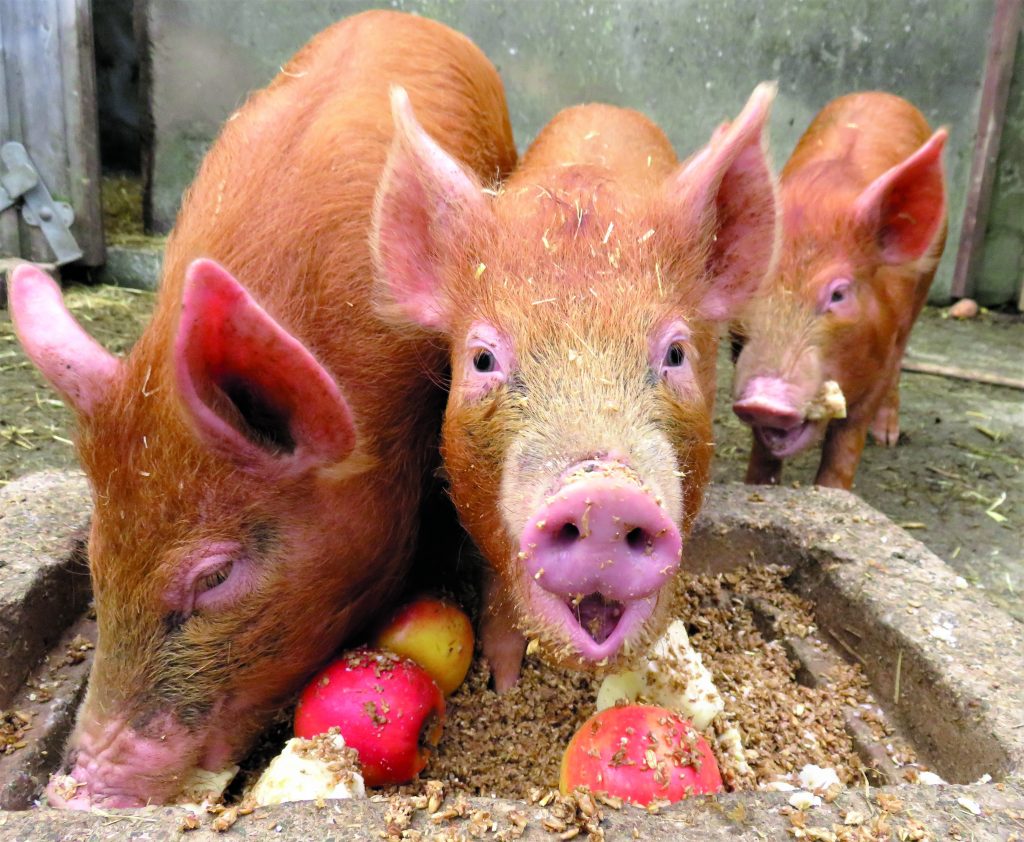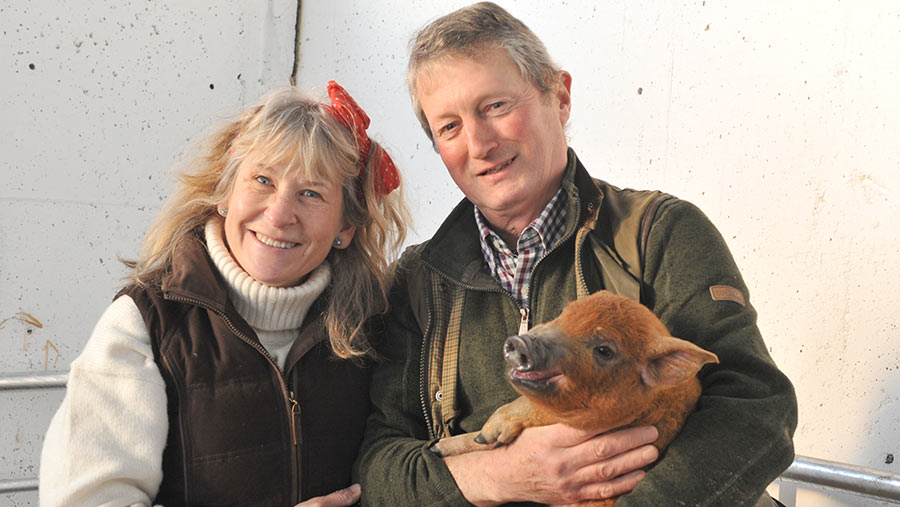How food and drink by-products can cut costs for pig producers

By-products from food and drink manufacturing are helping to future-proof pig farms from rising feed costs.
Co-products can cost as little as £1.20 per percentage point of dry matter (DM) and their appeal extends beyond price, says pig nutritionist Phil Baynes.
See also: How a pig feed system is helping cut costs
Weight gain optimisation can be maintained if the diet is formulated correctly, says Dr Baynes.
But he warns that each ingredient must be analysed to ensure it delivers an accurate and balanced diet to the pig group it is being fed to.
“Pigs are quite happy to eat co-products and these ingredients do a good job.
There are an awful lot of opportunities for using these products,’’ Dr Baynes insists.
All co-products included in pig diets must be Feed Materials Assurance Scheme (Femas) certified.
Here are some of the options.
Liquid whey
A by-product of cheese production.
Cost
A bulky product, therefore price is dictated by haulage and distance from the factory; expect to pay £1.20-£1.50/per percentage point of DM (whey is typically about 5% DM).
Which age of pigs is it suitable for?
Any age, but, as a highly digestible feed, it is especially suitable for young pigs; it contains approximately 65% lactose.
Key nutrients
- Typically More than 11% protein
- Contains B-vitamins, which are critical for optimal metabolic function, calcium, phosphorus and salt.
Key considerations when feeding
Generally added at a rate up to 20% on a DM basis to complement other feed ingredients of cereals and proteins.
Can contain significant levels of salt, as much as 10% on a DM basis, so ensure ad-lib access to drinking water to avoid salt toxicity.
The source – whether from cottage or hard cheese – will affect the nutritional composition so it is important to analyse the material to understand what is being used. Analyse at regular intervals to ensure consistency.
Any pros and cons?
Digestive upset, such as “whey bloat”, can occur in pigs when it is abruptly included in liquid feed or fed at high dietary levels. Feeding it to lactating sows may cause diarrhoea.
Brewers’ grains
A co-product from the production of beer.
Cost
Local breweries may supply spent grains at no charge, but if sourced from a feed supply company, expect to pay about £45/t delivered to farm, but price will vary according to farm location.
Which age is it suitable for?
Given its presentation as a moist product, it can be difficult to incorporate practically in pig rations.
It is normally used in ruminant diets, but can be successfully fed to sows at up to 15% of the diet if there is a method of doing so.
Not suitable for piglets, as they lack the enzymes needed to properly digest this feed.
Key nutrients
A palatable, moist feed with high protein content, typically 18-23%, low in starch and high in crude fibre.
Key considerations when feeding
Feed at 150g/kg – any higher and it will affect growth rates. Mix with a dry component.
Any pros and cons?
A moist product, so it can be difficult to feed, but some producers have invested in macerators, which allow them to feed it as a liquid by mixing it with water or another liquid, such as beer waste.
Should be used within three days.
Brewers’ yeast
Surplus deactivated yeast from the brewing industry.
Cost
£2-£2.50 per percentage point of DM (brewers’ yeast is typically 12-14% DM).
Which age of pigs is it suitable for?
Growers from 15-20kg onwards.
Which key nutrients does it supply?
- A rich source of protein and phosphorous, which is important for biochemical functions and bone integrity
- Very good amino acid levels
Key considerations when feeding
Can be bitter and unpalatable for younger pigs, so it is better suited to older pigs, whose hunger is more established.
If preserved with a small amount of organic acid, it can be kept for at least six weeks, but would need to be agitated as it will sediment if left undisturbed.
Any pros and cons?
Live yeast can ferment in tanks and feed lines, creating air blockages.
It is illegal to ship or feed live yeast, therefore each load must be treated with a propionic-based organic acid to kill any residual activity.
Other co-products to consider
Cheese
Pigs love the fifth flavour sensation, the umami flavour, and cheese has a high degree of this.
It is rich in protein and high in energy and is an ideal product on a nutritional front, but cheese is difficult to feed because it is gooey and it can’t be used in a liquid feed system because it doesn’t liquefy.
It could be freeze-dried and fed as a powder, but this process is cost-prohibitive.
“Some farmers might be offered cheese from a Femas-registered supplier and they might just feed it straight from the trough and let the pigs enjoy it as a treat,’’ says Dr Baynes.
Volume surplus fruit and vegetables
These have little energy benefit for pigs in their growing phase, but are an excellent source of forage, therefore tick many boxes on pig welfare.
Nutritional content varies according to product fed – for instance, peas provide 22% crude protein, but cooked potatoes just 2.2%.
Case study: Hugh and Katharine Brookes

Feeding pigs co-products ranging from liquid whey and fruit to cheese and brewers’ grains is allowing an outdoor producer to run a closed-loop system.
Carmarthenshire-based Penlan Heritage Breeds, run by Hugh and Katharine Brookes, supplies Mangalitza pigs to high-end restaurants, where chefs want meat with flavour, marbling and a specific layer of fat.
As this breed is slow finishing, the protein levels in proprietary feeds formulated for the modern pig is too high, says Mrs Brookes.
To achieve the right balance of nutrition for her 200-head herd, she researched the nutritional content of these feeds and worked out how this could be delivered by co-products, while adjusting the protein level to suit each pig group.
Pigs are now fed high-calorie whey and brewers’ grains, supplied free by local businesses.
Surplus seasonal fruit and vegetables are bought from a wholesaler.
When availability is more restricted in the winter, fodder beet is bought to plug the gap.
An optimum diet Mrs Brookes formulates for a grower contains 1.4kg of brewers’ grains, 0.5kg cheese, 1.8-2.7kg fruit and vegetables and five to 10 litres of whey, topped up with whole barley.
For producers considering this feeding system, she says it is important to observe the symbiotic relationship with the supplier.
“You are a service to them as much as they are to you – you have to be there for them to take their products.’’
Mrs Brookes feeds the co-products in troughs but, for the bigger groups, she is introducing a simpler system, where pigs will be fed off the concrete floor in refurbished housing.
